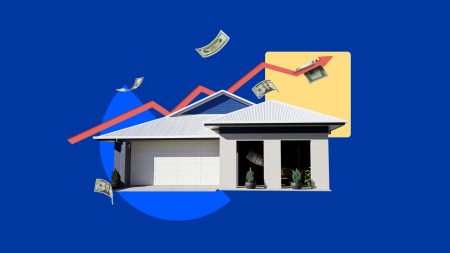@TonyTheTigersSon/Twenty20
Key takeaways
- With a 10/1 or 10/6 ARM, you’ll have a fluctuating interest rate after a set introductory period, while with a 30-year fixed-rate mortgage, the rate never changes.
- For their first decade, the ARMs offer a lower interest rate than the 30-year fixed-rate mortgage.
- Your financial circumstances, long-term plans and tolerance for rate variability play a significant role in deciding the right mortgage type for you.
Various types of mortgages are available to meet different home financing needs. Adjustable-rate mortgages, including the 10/1 ARM and the 10/6 ARM, are common options in addition to the traditional 30-year fixed-rate mortgage. ARMs and fixed-rate mortgage interest rates are directly tied to the economy, but there are key differences.
Differences between a 10/1 or 10/6 ARM and 30-year fixed-rate mortgage
Both types of ARMs (the 10/1 and the 10/6) and the 30-year fixed mortgage are loans with 30-year terms. The key difference lies in how their interest rates change.
In a 30-year fixed-rate mortgage, the interest rate is set at the beginning of the loan term, and remains unchanged for the loan’s duration.
For the first 10 years, the interest rate on a 10/6 or 10/1 ARM stays the same every month, just like a fixed-rate mortgage. But after that decade ends, it becomes a variable rate, and continues to be so until the end of the mortgage term. With a 10/1 ARM, the interest rate adjusts every year. With a 10/6 ARM, the interest rate adjusts every six months.
So, let’s say you close your loan on December 30, 2024. On December 30, 2034, your interest rate will change — moving either up or down based on movement in the index the rate is tied to.
The rate will adjust again annually or bi-annually until you pay off the loan, sell the home or refinance the mortgage. Each time the rate changes, your monthly payment amount changes to reflect the difference in interest. Generally, there are caps on how much the interest rate can change within the designated period and over the lifetime of the loan.
10/1 ARM vs. 10-year fixed mortgage
Don’t confuse a 10/1 ARM with a 10-year fixed-rate mortgage. A 10/1 ARM is a 30-year mortgage with a 10-year introductory rate period; the rate then adjusts annually. A 10-year fixed-rate mortgage is a fixed-rate loan with a term of only a decade. That means your monthly payment will be much larger with the 10-year fixed-rate mortgage than with the 10/1 ARM because you’re paying off the loan in 10 years instead of 30. While your payment will be larger, the upside is you’ll pay off your mortgage much faster, and you’ll pay less total interest.
Example of a 10/1 ARM vs. 30-year mortgage
Let’s compare the costs of a 10/1 ARM with a 30-year fixed-rate mortgage. For this example, we’ll use a loan of $350,000 with a rate of 6.49 percent for the ARM and 6.99 percent for the 30-year fixed. Here’s a glimpse at how the first 10 years would look:
| 10/1 ARM | 30-year fixed-rate mortgage | |
|---|---|---|
| APR | 6.49% | 6.99% |
| Monthly payment | $2,209.94 | $2,326.21 |
| Remaining principal after 10 years | $296,641.39 | $300,272.48 |
Over the first 10 years, the 10/1 ARM is a clear winner: You save more than $100 per month to free up additional room in your budget, and you make a bigger dent in the principal balance.
Once the introductory period is over, you could be on a rocky road. Let’s say your ARM has a lifetime cap of 11.49 percent (a maximum increase of 5 percent). If the benchmark rate has risen to your cap (or higher), your payment would be $3,135.15. In contrast, those with a fixed rate would maintain the same payment of $2,326.21.

ARM or fixed-rate calculator
Use our ARM or fixed-rate calculator to make comparisons using your own information.
Use the calculator
What to consider
If you’re comparing a 10/1 ARM vs. a 30-year fixed-rate mortgage, consider the following questions:
- How much are you saving? The big reason to consider a 10/1 ARM is the potential for a lower minimum monthly payment. So, do the math to determine whether the savings now are worth the potential uncertainty in the future.
- What is your plan for the extra money you might save with an ARM? Make a plan for how you’ll make the most of your savings. Will you make additional payments to the principal to accumulate equity faster? Or can you use the money to pay off debt or put it toward your retirement?
- How long are you planning to be in the home? If this home is a starter home, a 10/1 ARM can be a wise choice. By selling the property in the first 10 years, you’ll never even have to worry about what an interest rate adjustment means for your budget.
- Can you afford the worst-case scenario? Even if you have plans to sell the home before the 10-year marker arrives, your plans might change. What will you do if you can’t sell the home or you’re unable to score a lower refinance rate? While it’s impossible to predict the future, you should be prepared to be able to pay a higher rate.
Is a 10/1 or 10/6 ARM worth it?
ARM rates look more attractive because they are usually lower than those attached to 30-year fixed-rate mortgages. However, fixed-rate mortgages come with a rate that always stays the same. By locking in your rate, your monthly payment stays the same. That means less uncertainty about your loan cost over time and easier budgeting.
Choosing between an ARM or a fixed-rate mortgage involves considering your finances and plans for the property. If you can get a lower interest rate and plan to refinance or sell within a decade, a 10/1 or 10/6 ARM can be a smart move. However, if you plan to own the property long term, a fixed-rate mortgage may make more sense.
10/1 or 10/6 ARM vs. 30 year fixed-rate mortgage FAQs
-
If you plan to stay in your home for a long time, a 30-year fixed mortgage is the better option. While a 10/1 ARM may offer initial savings, the potential for higher interest rates in the future could outweigh these savings if you end up keeping the loan for an extended period. A 30-year fixed mortgage, on the other hand, offers the stability of a consistent interest rate for the entire loan term, making long-term planning easier.
-
A 10/1 ARM often has a lower initial interest rate compared to a 30-year fixed-rate mortgage, generally about 0.25 to 0.5 percent less. The initial rate of a 10/1 ARM is typically set below current market rates, which makes it an appealing choice in a high-interest rate environment. However, this lower rate only lasts for the first 10 years before it starts adjusting annually based on the prevailing market conditions.
Also, while there’s a discount on the interest rates, fees and closing costs can actually make the ARM more expensive than the 30-year loan. For example, in Bankrate’s survey of lenders, as of early July 2024, a 10/1 ARM is averaging an 8.02 percent APR — compared to 7.11 percent for the average 30-year fixed-rate mortgage.If you’re after a lower interest rate, consider a shorter-term fixed-rate mortgage, like a 10- or 15-year loan. These loans often offer not only a better rate but also reduced costs than a 10/1 ARM.
-
If you plan to sell or refinance your home before the initial fixed-rate period ends on a 10/1 ARM, you may be subject to prepayment penalties.
These penalties can be either hard or soft, depending on your lender and loan terms. A hard prepayment penalty will penalize you for selling or refinancing your home during a prescribed period (usually the first few years of the loan term), while a soft prepayment penalty allows you to sell your home freely but penalizes refinancing the mortgage.
Additionally, refinancing your mortgage comes with closing costs, typically ranging from 2 percent to 5 percent of the loan amount. When choosing between a 10/1 ARM vs. a 30-year fixed mortgage, consider your long-term plans, 30-year fixed vs. 10/1 ARM pros and cons and whether the potential risks and costs of an ARM outweigh the initial benefits.
Read the full article here










